Best Data Catalog: How to Find a Tool That Grows With Your Business
Share this article
If you’re looking for a data catalog, your initial query likely revolves around identifying the best data catalog available. So, you might search for a list of the most popular data catalogs, which is a good step. However, this exercise won’t help you determine the best fit for your organization.
A better approach to finding the best data catalog for your organization would be to explore capabilities essential to maximizing the potential of your data estate. Then, you can identify the data catalog with these features to fulfill your organization’s requirements.
Keep reading to gain insights into selecting the best data catalog tool for your organization’s needs.

Looking for a data catalog with an ROI you can present to your CDO? Atlan is designed for adoption and embedded with automation. It helps you save time, cut cloud costs, and make faster, better decisions that lead to revenue.
Table of contents
Permalink to “Table of contents”- What is the best data catalog for your organization?
- Capabilities
- The best data catalog activates your data stack
- Related reads
What is the best data catalog for your organization?
Permalink to “What is the best data catalog for your organization?”The best data catalog drives value and helps foster data culture in your organization. It would meet your unique use cases by being:
- Open, extensible, and scalable as your use cases, technology, and goals will evolve over time
- Interoperable to connect with your existing tech stack and bring in data assets from numerous sources used by diverse teams
- Ideal for your budget, resources, business goals, and growth strategy
It also offers a rich, seamless experience for technical and business users in your organization.
Dive deeper → Data Catalog Guide: What to Look For and Where They’re Going
Now that we’ve explored what makes a data catalog the best fit for your organization, let’s dive into the key capabilities that help you pick the right solution for your needs.
What are the capabilities of the best data catalog for your organization?
Permalink to “What are the capabilities of the best data catalog for your organization?”The best enterprise data catalog would be modern in its approach and capabilities. For instance, it should address your organization’s emerging requirements and use cases, while being easy to implement and use.
Here are six essential capabilities you should look for to find the best data catalog for your organization:
- The data catalog solution provider has a partner, rather than a vendor approach
- The data catalog leverages automation for faster time-to-value
- The data catalog automates data lineage for a single pane of glass, i.e., comprehensive and unified data lineage information in one centralized view
- The data catalog is quickly adopted by data and business teams
- The data catalog is configurable and flexible for diverse teams and stacks
- The data catalog partner has an extensible platform approach
Let’s delve into the specifics of each capability.
1. Partner, not vendor approach
Permalink to “1. Partner, not vendor approach”A data catalog provider should act as a partner rather than a vendor. That means a data catalog provider should tailor the implementation approach to your organization’s needs and strategy, which will help drive adoption across teams.
Such a customized approach will future-proof your organization and empower you to adopt a modern data architecture, such as a data mesh or a data fabric.
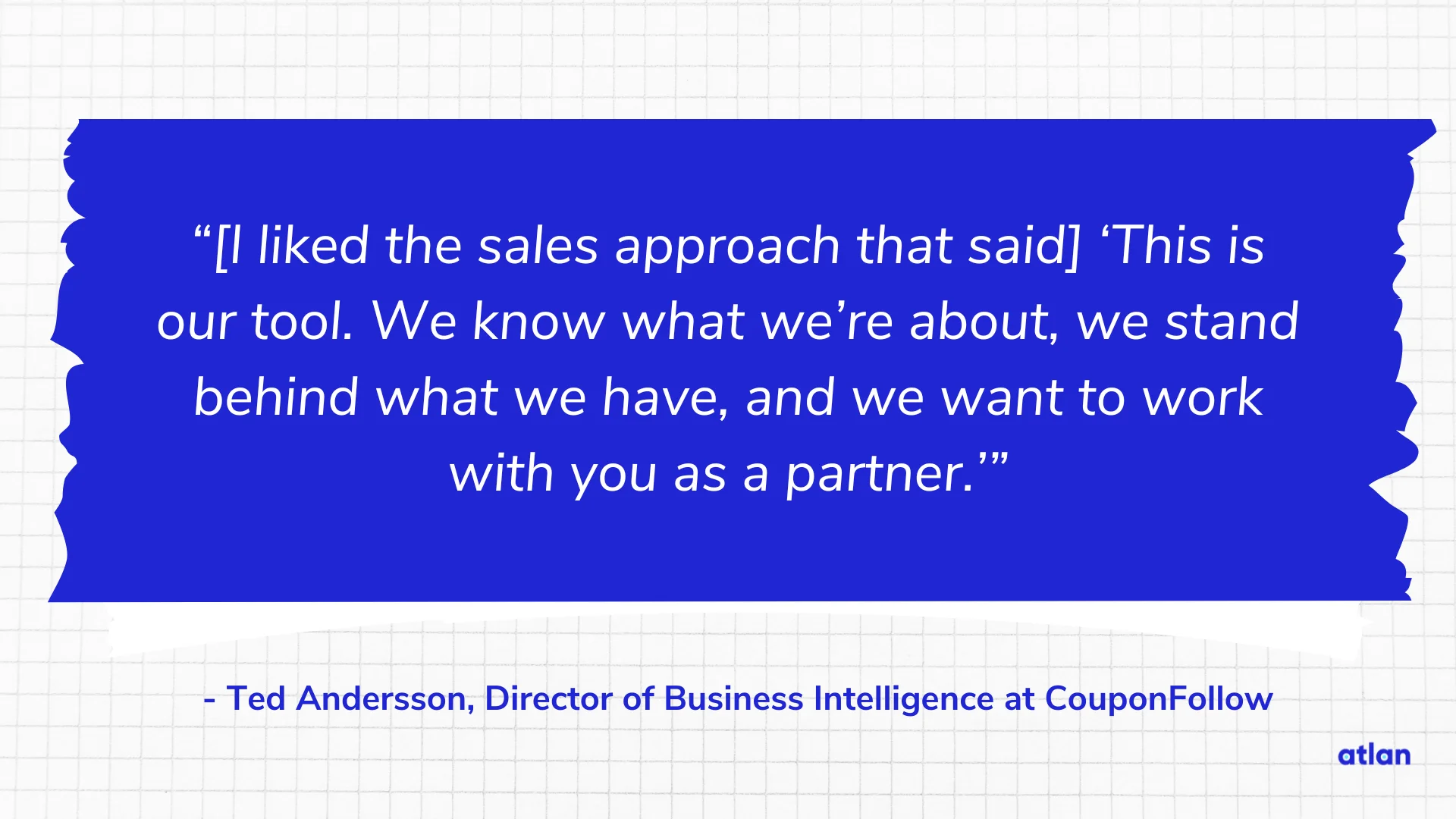
Partner, not vendor approach - Source: Ted Andersson, Director of Business Intelligence at CouponFollow on how he preferred a partner-centric approach to cataloging.
The data catalog partner also helps you build a data culture, further supporting your efforts to drive and scale user adoption.
For instance, the data catalog partner could provide adequate documentation, facilitate training and knowledge-sharing sessions, and perform active onboarding. This ensures that the data catalog drives value rather than becoming expensive shelfware.
Next, let’s move on to another critical capability of the best data catalog — leveraging automation for faster time-to-value.
2. Automation for faster time-to-value
Permalink to “2. Automation for faster time-to-value”A huge barrier to adopting a data catalog is the upfront manual work of mapping, defining, and maintaining accurate metadata for every asset.
So, look for a data catalog that offers auto-ingestion of metadata, AI-suggested documentation, and rule-based tagging and classification.
For instance, the best data catalog would automatically infer and suggest metadata for repeated assets, eliminating grunt work. These suggestions could include data asset descriptions, ownership, classification, and related terms.
Brazilian insurance and banking giant Porto used rule-based bulk automation to reduce the manual effort spent defining asset owners, enriching data assets, and securing sensitive data by 40%.
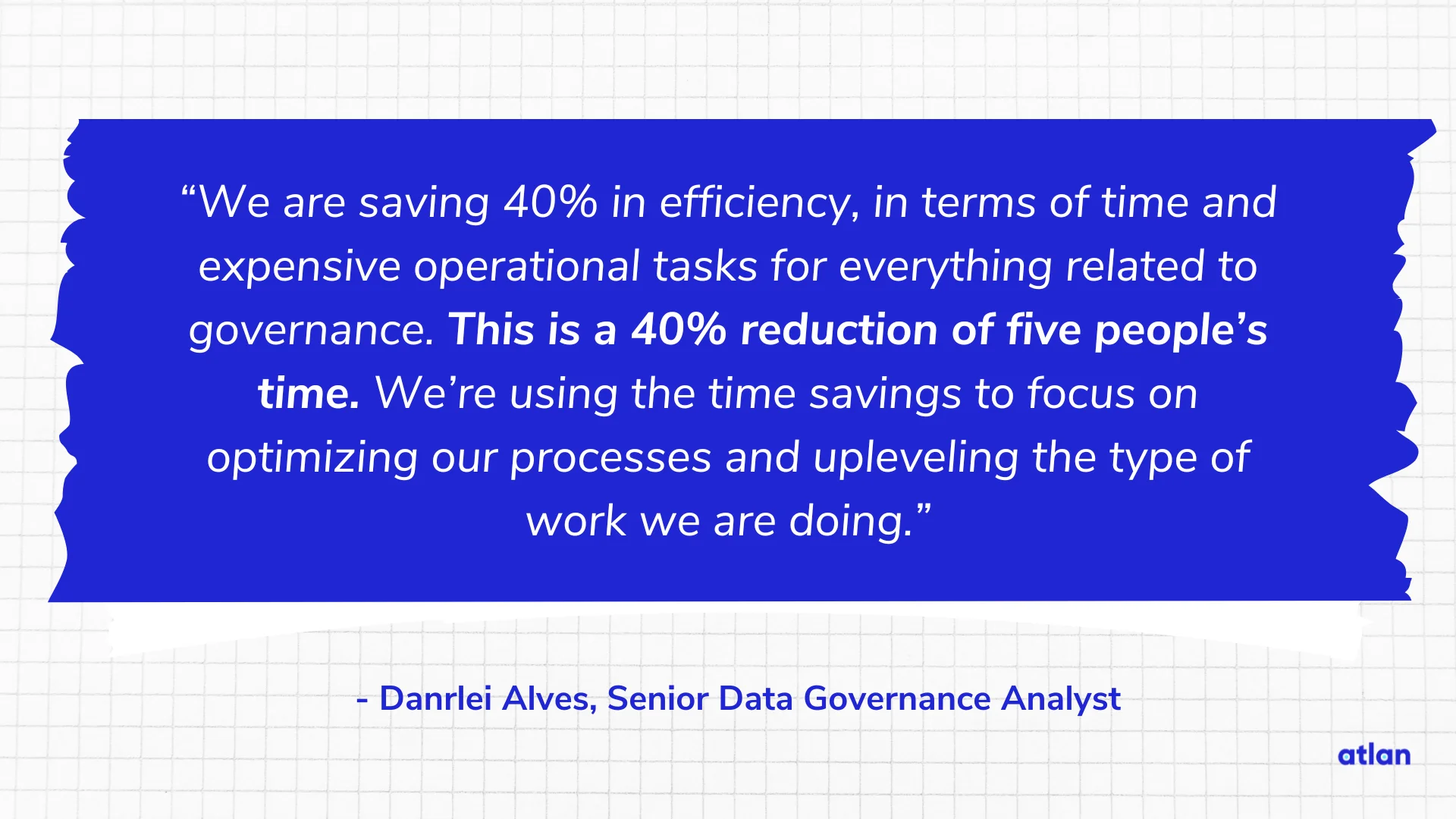
Automation for faster time-to-value - Source: Danrlei Alves, Senior Data Governance Analyst.
Porto also uses automation to comply with LGPD (Brazil’s General Data Protection Law).
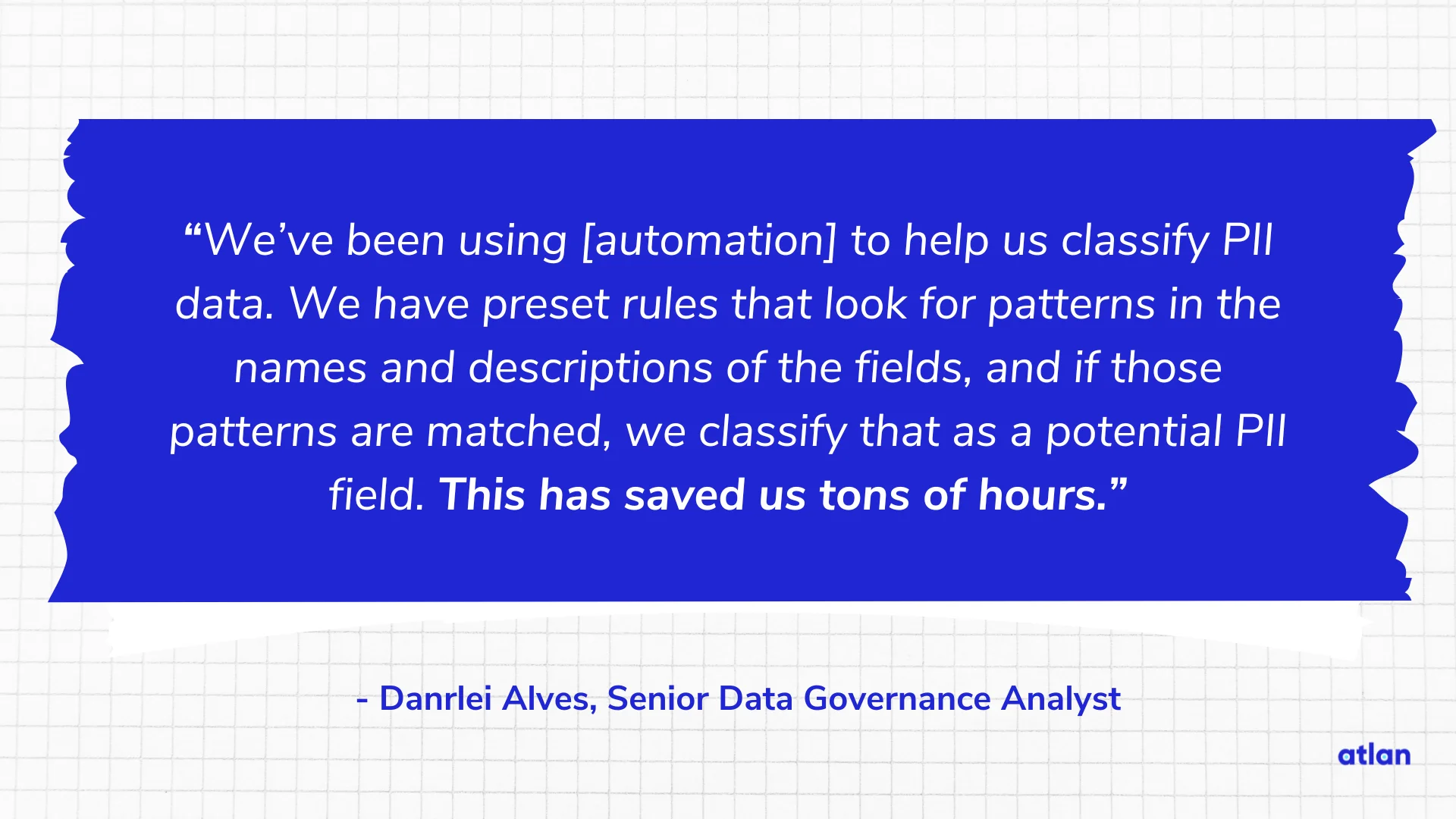
This has saved us tons of hours - Source: Danrlei Alves, Senior Data Governance Analyst.
Now, let’s look at another essential capability of the best data catalog — automating data lineage and providing comprehensive, unified data lineage information in one centralized view (i.e., a single pane of glass).
3. Lineage for a single pane of glass
Permalink to “3. Lineage for a single pane of glass”Many data catalogs mention data lineage as a feature. However, the best data catalogs would be capable of automatically compiling and managing it, down to a column level.
What does automated lineage entail? Rather than an engineer having to trawl through lineage to fix an issue reactively, cross-system automated data lineage would proactively:
- Map data asset relationships
- Track lineage back to the source
- Alert you to the downstream impacts of the changes you make to an asset
- Stay up-to-date
- Enable embedded collaboration, such as the ability to launch Slack conversations in Slack or create JIRA tickets
As a result, you automatically have a clear and complete visualization of how data flows through various processes, transformations, and systems, all within a single interface or dashboard. You don’t have to navigate multiple platforms or tools to get a holistic view of data movement and transformation across the organization.
With automated lineage, footwear company Dr. Martens reduced the time spent investigating and preparing for the potential impacts of a column name change from 4-6 weeks to 30 minutes.
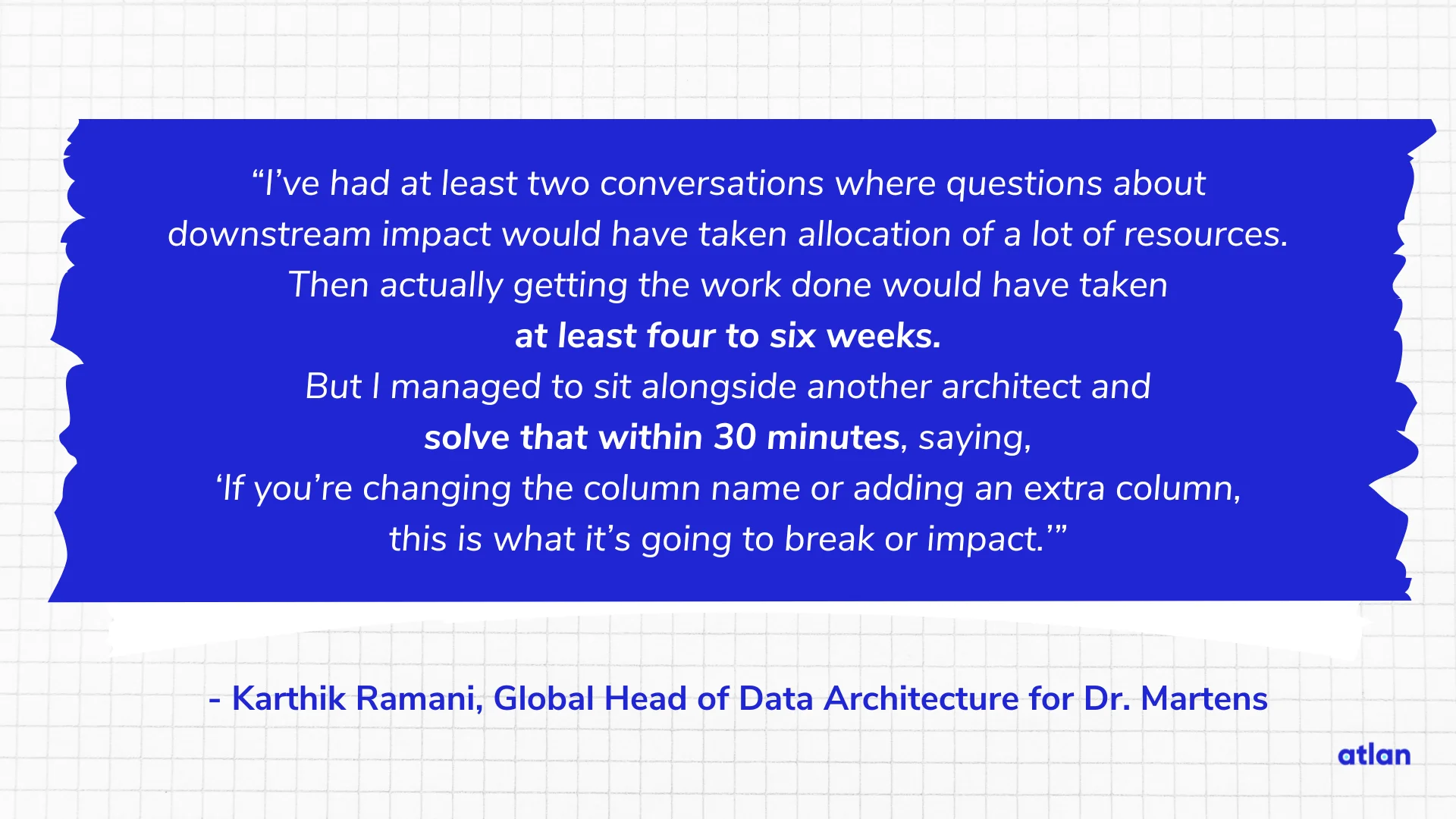
Lineage for a single pane of glass - Source: Karthik Ramani, Global Head of Data Architecture for Dr. Martens, on the benefits of automated lineage.
So, look for a data catalog with out-of-the-box connectors (OOTBs) that integrate with all your data stack tools and make lineage mapping automatic, intuitive, and actionable.
Next up is ensuring easy adoption by diverse data practitioners — business or technical users.
4. Adoption by data and business teams
Permalink to “4. Adoption by data and business teams”Traditionally, data catalogs have felt isolated from users’ daily work. Leveraging the data catalog felt disruptive and like context switching. It would also need the assistance of someone from engineering.
That’s why the best data catalog would be easy to use and a one-stop shop for all things data. It would be a home for data practitioners to search, understand, collaborate, discuss, and come together.
Let’s see how.
Personalized, intuitive UX
The catalog would offer an intuitive UX that can be personalized based on roles — data analyst, data scientist, engineer, or business user.
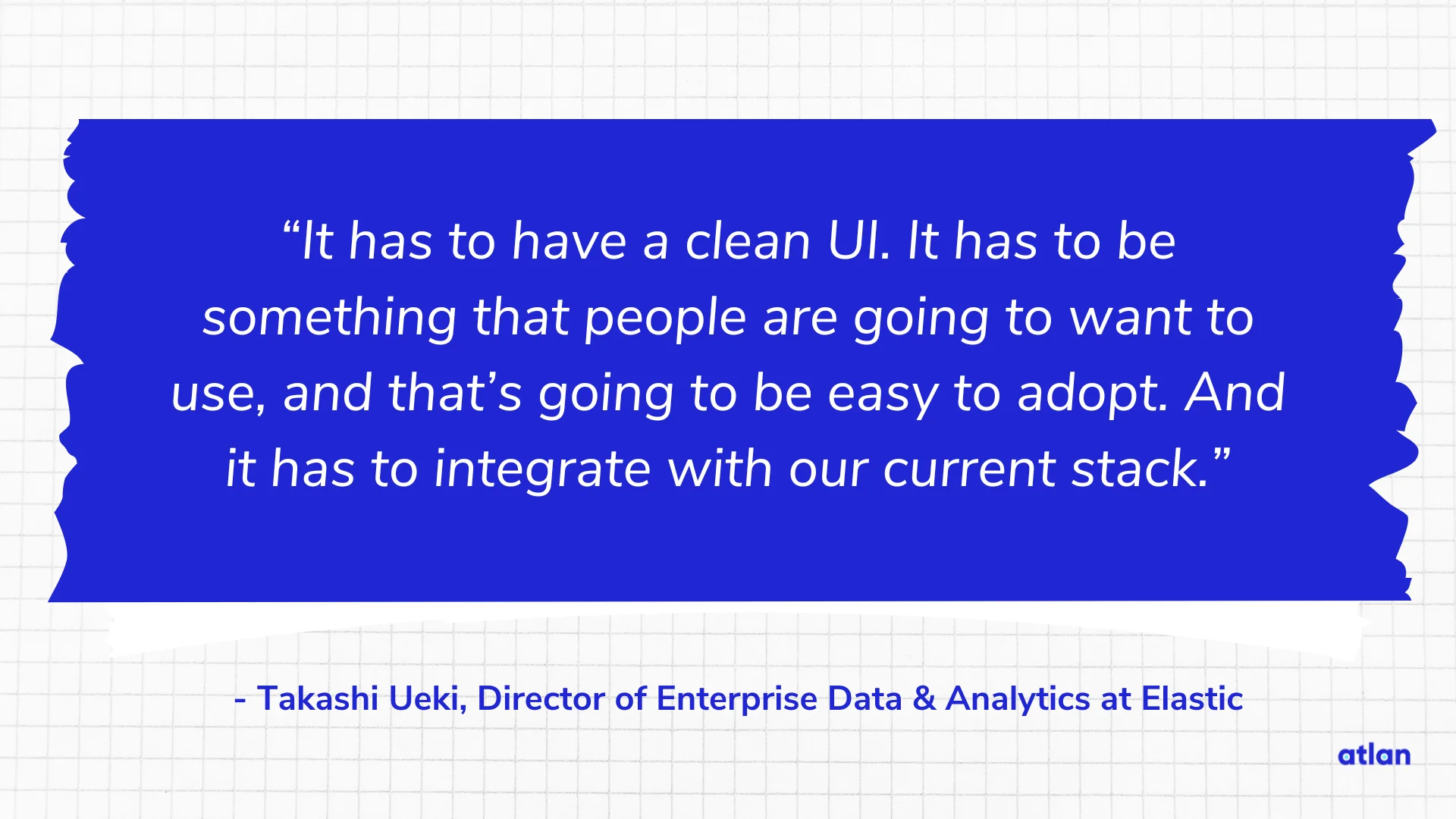
Personalized, intuitive UX - Source: Takashi Ueki, Director of Enterprise Data & Analytics, on the best data catalog for Elastic.
Data engineers can search through data using SQL syntax, whereas business users can search using natural language.
The data catalog would provide filters, such as last run status, certification status, owners, update frequency, and more. It would also populate usage stats (top and recent users in the last 30 days) or popularity metrics (most frequently run queries, the slowest-running queries, or the most expensive queries).
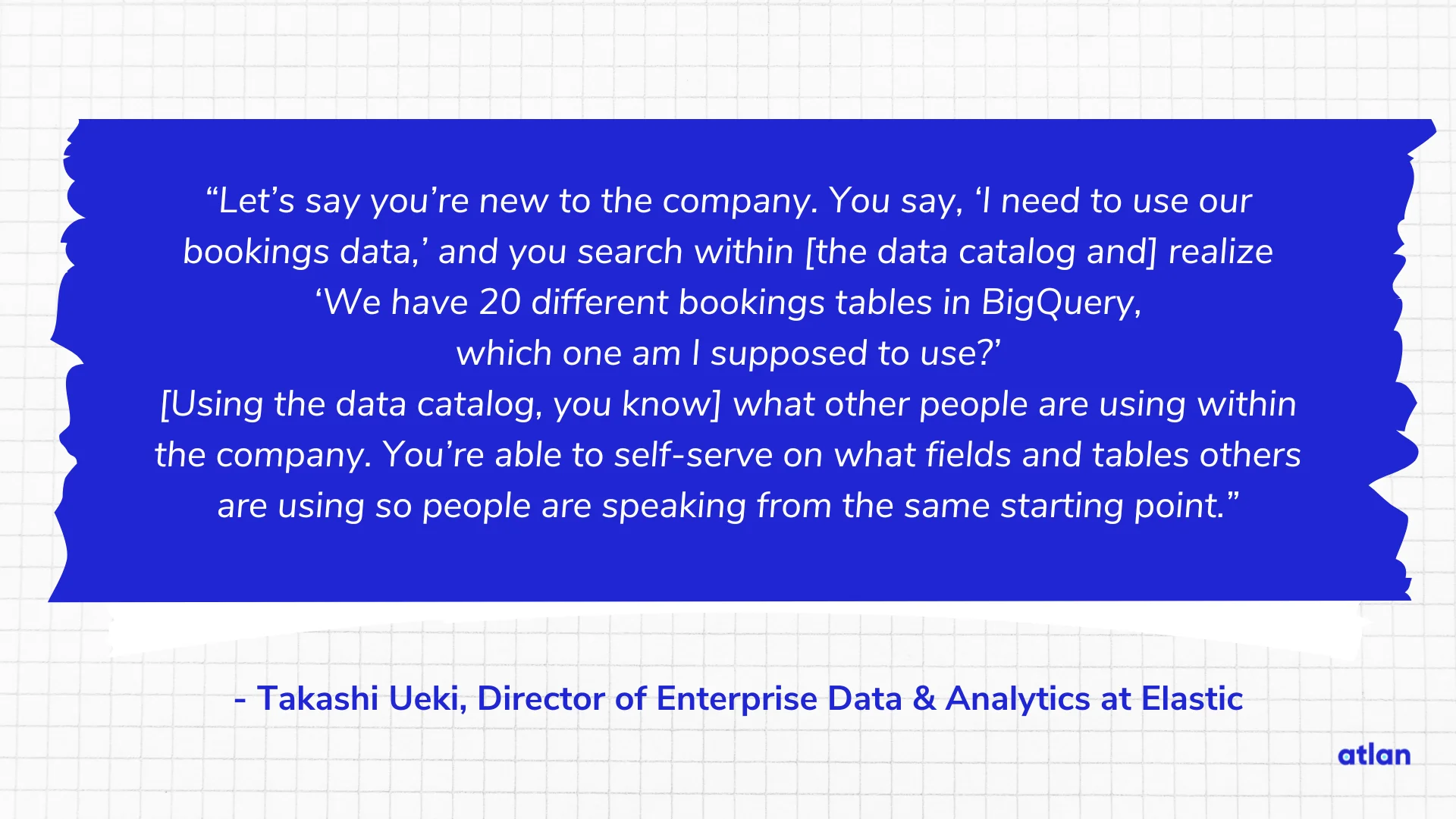
Adoption by data and business teams - Source: Takashi Ueki, Director of Enterprise Data & Analytics at Elastic on popularity metrics.
Enriched context for better understanding and insights
The best data catalog would enrich your context with a business glossary. The glossary would help understand your data assets’ key characteristics, with brief definitions, concepts, detailed README sections, and explanations for metrics.
The glossary would also list associated data assets, usage contexts, related terms, ownership, verification status, and more.
Aliaxis launched an organization-wide business glossary catering to the unique needs of global and regional stakeholders, facilitating better visibility and an open, collaborative sharing of ideas and projects.
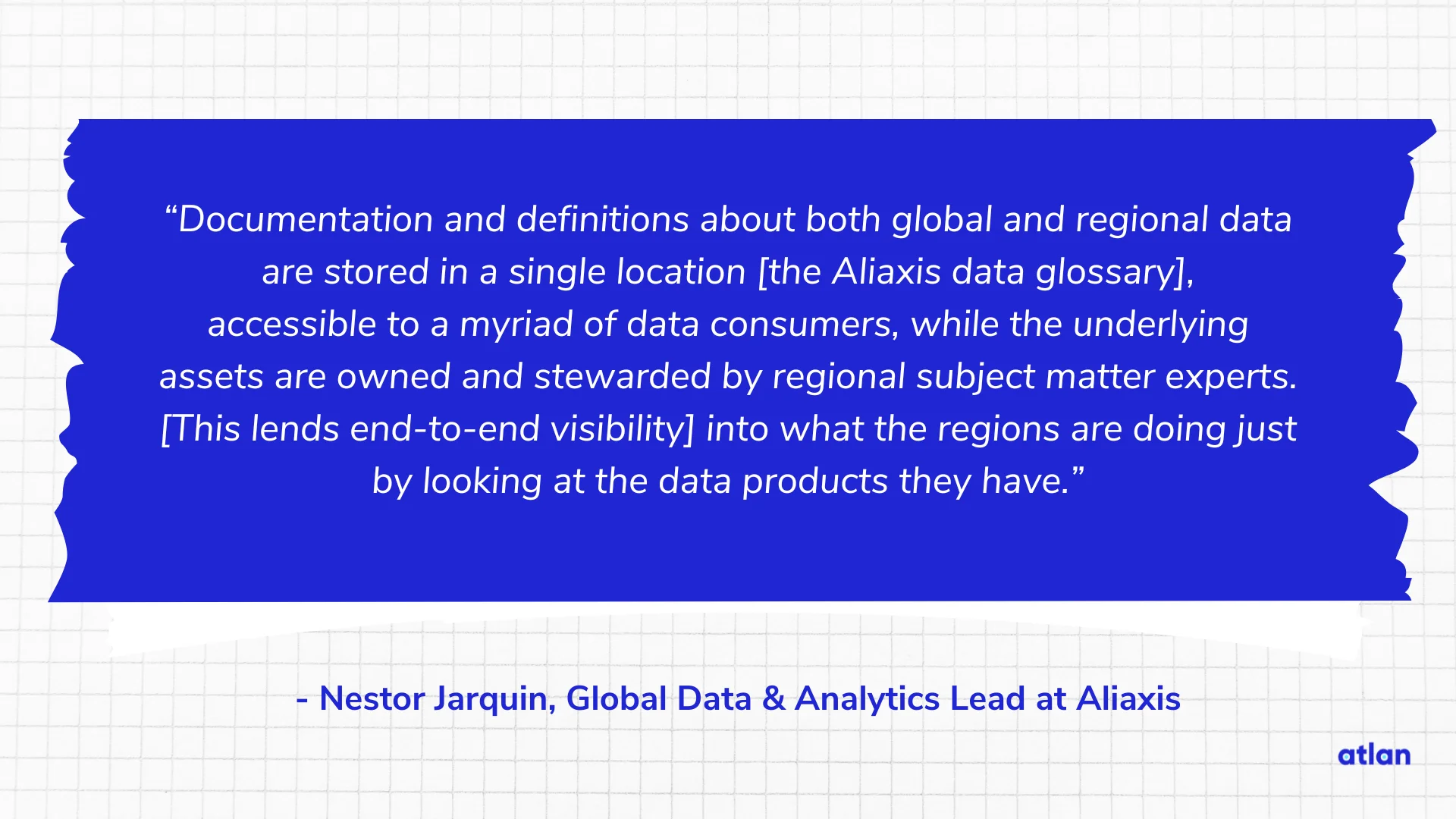
Enriched context for better understanding and insights - Source: Nestor Jarquin, Global Data & Analytics Lead at Aliaxis on business glossary benefits.
Dive deeper → What is a business glossary?
Embedded collaboration
The best data catalog would promote embedded collaboration. For instance, it can be embedded in BI tools via Chrome extensions so that you don’t have to switch apps; instead, it works seamlessly.
It also empowers you to have Slack discussions, ask questions about data, or raise support requests without leaving the catalog.
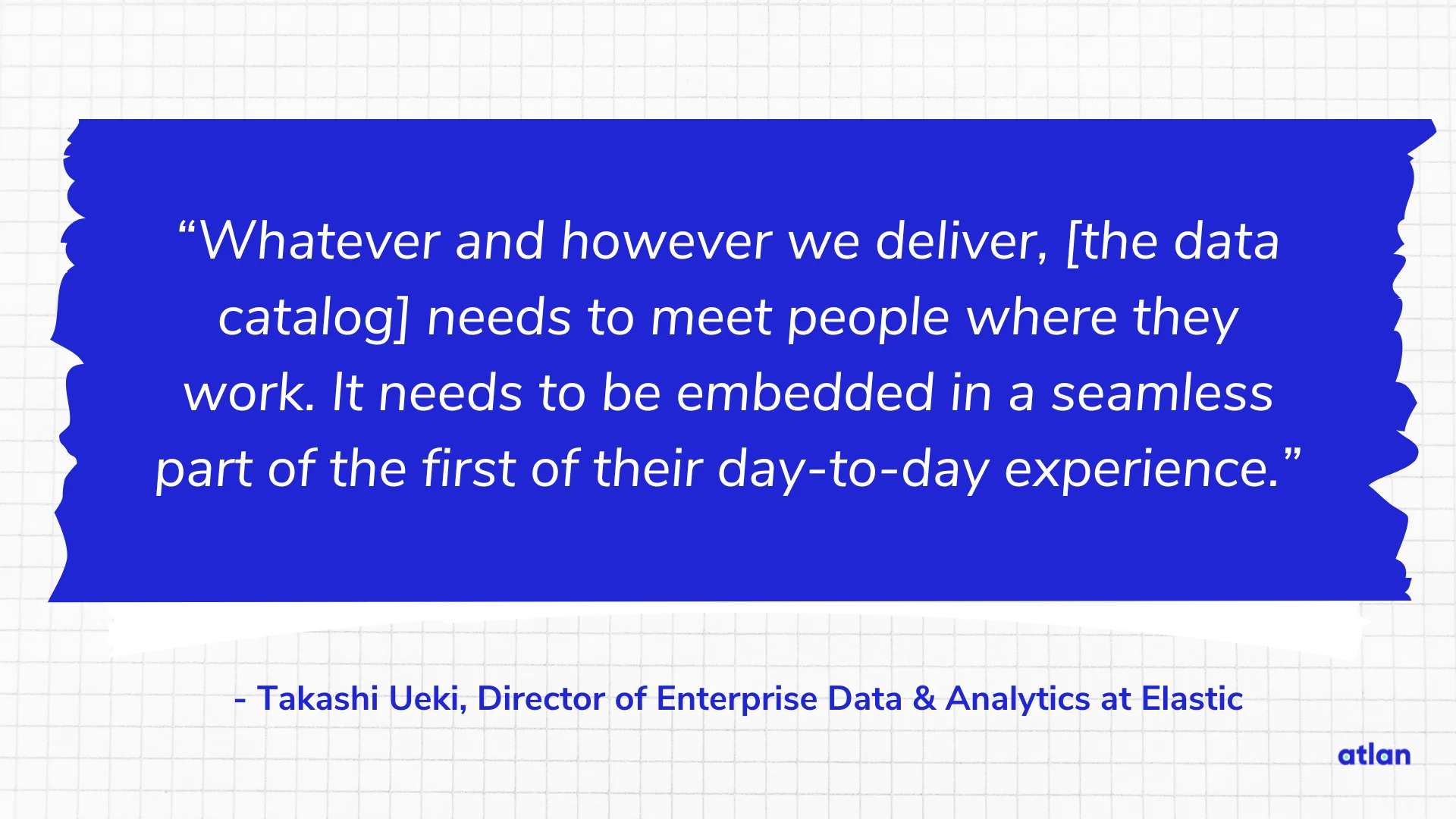
Embedded collaboration - Source: Takashi Ueki, Director of Enterprise Data & Analytics at Elastic on embedded collaboration.
Dive deeper → Embedded collaboration 101
An AI copilot for data teams
The best data catalog would act as an AI copilot — auto-drafting documentation for business terms and data assets, simplifying complex SQL transformations into natural language, supporting natural language exploration, and more.
Dive deeper → AI Data Catalog: Everything you hoped for and more
Now, let’s look at the fifth critical capability of the best data catalog — ensuring that it’s configurable and flexible for diverse data teams and tech stacks.
5. Configurable and flexible for diverse teams and stacks
Permalink to “5. Configurable and flexible for diverse teams and stacks”A data catalog must be an asset to every team in your organization, not just the data team. However, adoption across every department can be difficult as each team’s and user’s data requirements differ.
For instance, a sales ops analyst looking for last quarter’s revenue has a very different set of questions and data needs than a product manager evaluating the adoption of a new feature.
That’s why the best data catalog would work for diverse users, use cases, and tools through a customizable and personalized approach.
They create personalized experiences catering to different roles and types, incorporating custom metadata to capture relevant fields, custom classifications, and tags for various data types. They also support custom masking and hashing policies for sensitive data.
For example, an engineer integrating details from a custom-built ETL processing engine could create custom metadata called ETL metadata group, with fields like job link, last run date, or last run status.
Lastly, let’s explore the need for a data catalog partner with an extensible platform approach.
6. Extensible platform approach
Permalink to “6. Extensible platform approach”The best data catalog should be ready for mission-critical data projects like training AI models, grappling with new possibilities and challenges.
So, the catalog’s architecture must be open and extensible. It can be easily expanded, customized, and integrated with other systems or technologies, making it versatile and adaptable to different needs and requirements.
The open architecture helps introduce new capabilities (GenAI support, for instance) quickly using custom connectors.
Payment app Yape was searching for an open, customizable, and extensible data catalog that helped them maintain their agile mindset — moving fast to try new tools and integrate them into Yape’s data ecosystem.
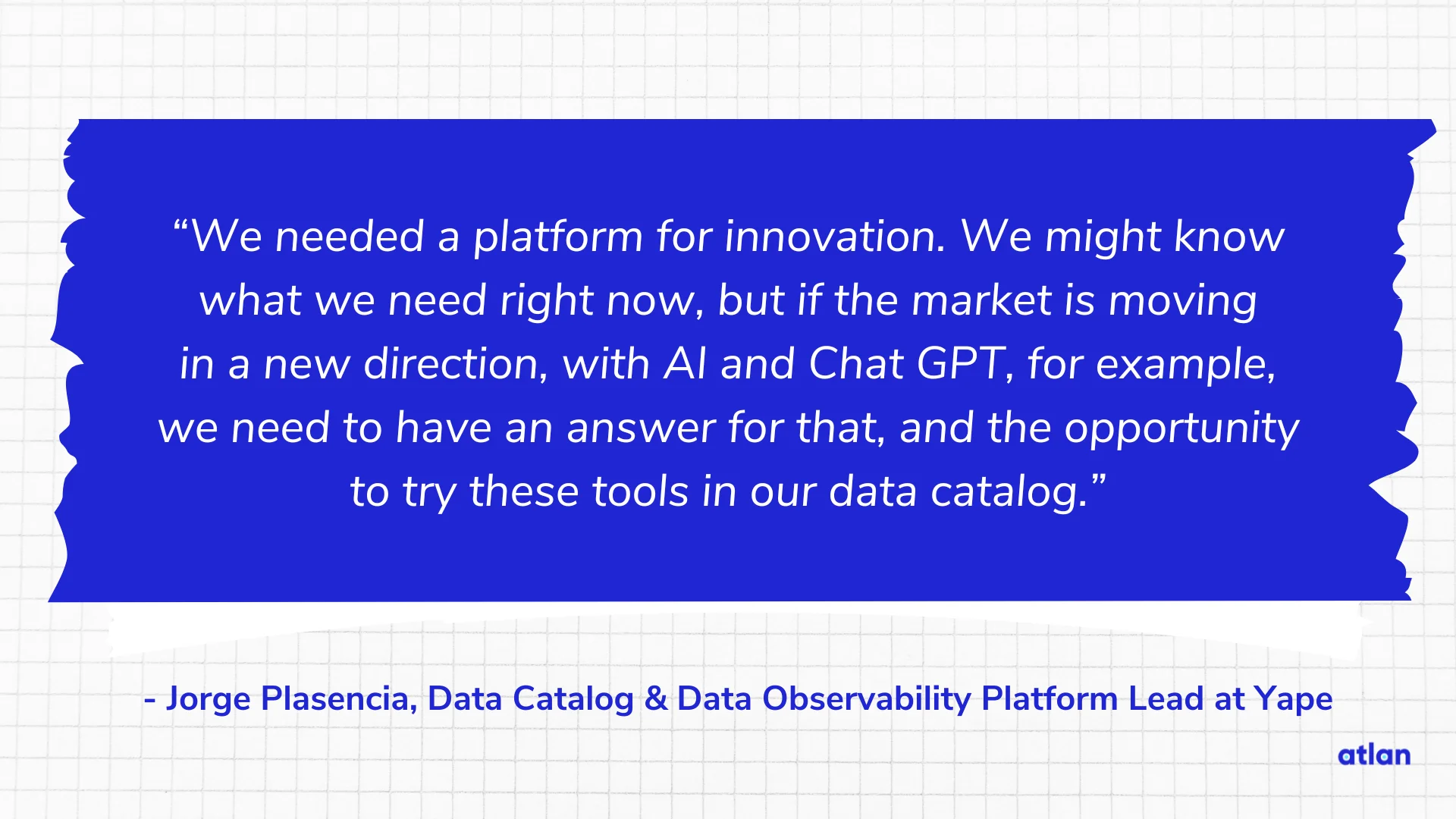
Extensible platform approach - Source: Jorge Plasencia, Data Catalog & Data Observability Platform Lead at Yape.
So, look for a data catalog that is open by default, supports active metadata management, and is easily customizable.
The best data catalog activates your data stack
Permalink to “The best data catalog activates your data stack”Your data estate is one of your organization’s most powerful assets. That’s why choosing the best data catalog is paramount to unlocking its full potential.
Pick a data catalog that evolves with your organization, empowers all teams, and fosters collaboration. The best data catalogs are powered by automation, active metadata management, and embedded collaboration. They’re also built by teams having a partner-centric approach, continuously innovating to lead the category and future-proof your data estate.
Such a setup is critical to powering informed decision-making, optimizing operations, fostering collaboration, and staying ahead of your competition.
Best data catalog: Related reads
Permalink to “Best data catalog: Related reads”- 15 Essential Features of Data Catalogs to Look for in 2024
- Data Catalog Adoption: What Limits It and How to Drive It Effectively
- 5 Main Benefits of a Data Catalog
- Data Catalogs 101
- Data catalogs in 2024
- Data lineage tools
- Data governance tools
- Data governance tools comparison
Share this article





















